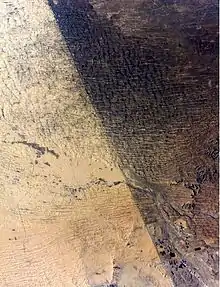Overgrazing
Overgrazing occurs when plants are exposed to intensive grazing for extended periods of time, or without sufficient recovery periods.[1] It can be caused by either livestock in poorly managed agricultural applications, game reserves, or nature reserves. It can also be caused by immobile, travel restricted populations of native or non-native wild animals.



Overgrazing reduces the usefulness, productivity and biodiversity of the land and is one cause of desertification and erosion. Overgrazing is also seen as a cause of the spread of invasive species of non-native plants and of weeds. Degrading land, emissions from animal agriculture and reducing the biomass in a ecosystem contribute directly to climate change[2] between grazing events. Successful planned grazing strategies have been in support of the American bison of the Great Plains,[3][4] or migratory wildebeest of the African savannas,[5] or by holistic planned grazing.[6]
Ecological impact
Overgrazing typically increases soil erosion.[7]
With continued overutilization of land for grazing, there is an increase in degradation. This leads to poor soil conditions that only xeric and early successional species can tolerate.[8]
Native plant grass species, both individual bunch grasses and in grasslands, are especially vulnerable. For example, excessive browsing by white-tailed deer can lead to the growth of less preferred species of grasses and ferns or non-native plant species[9] that can potentially displace native, woody plants, decreasing the biodiversity.[10]
Economic theory
Overgrazing is used as an example in the economic concept now known as the Tragedy of the Commons devised in a 1968 paper by Garrett Hardin.[11] This cited the work of a Victorian economist who used as an example the over-grazing of common land. Hardin's example could only apply to unregulated use of land regarded as a common resource.
Normally, rights of use of common land in England and Wales were, and still are, closely regulated, and available only to "commoners". If excessive use was made of common land, for example in overgrazing, a common would be "stinted", that is, a limit would be put on the number of animals each commoner was allowed to graze. These regulations were responsive to demographic and economic pressure; thus rather than let a common become degraded, access was restricted even further. This important part of actual historic practice was absent from the economic model of Hardin.[12] In reality the use of common land in England and Wales was a triumph of conserving a scarce resource using agreed custom and practice.
By region
Africa-Sahel region
There have been overgrazing consequences in the region Sahel region. The violent herder–farmer conflicts in Nigeria, Mali, Sudan and other countries in the Sahel region have been exacerbated by land degradation and overgrazing.[13][14] See 2010 Sahel famine.
Sub-Sahara Africa
Various countries in Sub-Sahara Africa are affected by overgrazing and resulting ecological effects. In Namibia, overgrazing is considered the main cause of woody plant encroachment at the expenses of grasses on a land area of up to 45 million hectares.
Australia
In many arid zones in Australia, overgrazing by sheep and cattle during the nineteenth century, as pastoralism was introduced by European settlers, caused many long-lived species of trees and shrubs to give way to short-lived annual plants and weed species. Introduced feral rabbits, cats and foxes exacerbated the threat to both flora and fauna. Many bird species have become extinct or endangered, and many of the medium-sized desert mammals are now completely extinct or only exist on a few islands of Australia.[15]
Overgrazing can also occur with native species. In the Australian Capital Territory, the local government in 2013 authorised a cull of 1455 kangaroos due to overgrazing.[16] Maisie Carr (1912-1988), Ecologist and Botanist, undertook significant research and studies in overgrazing and established consequences on the surrounding land in Australia.
See also
References
- Mysterud, Atle (2006). "The concept of overgrazing and its role in management of large herbivores". Wildlife Biology. 12 (2): 129–141. doi:10.2981/0909-6396(2006)12[129:TCOOAI]2.0.CO;2. ISSN 0909-6396. S2CID 55599448.
- "The relationship between overgrazing and the US environment". ArcGIS StoryMaps. 13 March 2020. Retrieved 2021-03-20.
- Laduke, Winona (1999). All Our Relations: Native Struggles for Land and Life. Cambridge, MA: South End Press. p. 146. ISBN 0896085996. Retrieved 30 March 2015.
- Duval, Clay. "Bison Conservation: Saving an Ecologically and Culturally Keystone Species" (PDF). Duke University. Archived from the original (PDF) on March 8, 2012. Retrieved April 13, 2015.
- In balance with, and accompanied by, prides of keystone predators.
- "Holistic Land Management: Key to Global Stability" by Terry Waghorn. Forbes. 20 December 2012.
- C. Michael Hogan (2009). "Overgrazing" (Archived 2010-07-11 at the Wayback Machine). Encyclopedia of Earth. Sidney Draggan, topic ed.; Cutler J. Cleveland, ed. Washington, D.C.: National Council for Science and the Environment.
- Fuls, E.R. "Ecosystem modification created by patch-overgrazing in semi-arid grassland". Journal of Arid Environments. 23 (1): 59–69. Bibcode:1992JArEn..23...59F. doi:10.1016/S0140-1963(18)30541-X.
- Côté, S. D., Rooney, T. P., Tremblay, J. P., Dussault, C., & Waller, D. M. (2004). "Ecological impacts of deer overabundance". Annu. Rev. Ecol. Evol. Syst., 35, 113-147.
- Baiser, B., Lockwood, J. L., La Puma, D., & Aronson, M. F. (2008). "A perfect storm: two ecosystem engineers interact to degrade deciduous forests of New Jersey". Biological Invasions, 10(6), 785-795.
- Garrett Hardin (December 13, 1968), "The Tragedy of the Commons", Science, Vol. 162, No. 3859, pp. 1243-1248. Also available here and here.
- Susan Jane Buck Cox (Spring 1985). "No Tragedy on the Commons". Journal of Environmental Ethics, Vol. 7.
- "The Deadliest Conflict You've Never Heard of". Foreign Policy. 23 January 2019.
- "The battle on the frontline of climate change in Mali". BBC News. 22 January 2019.
- "Arid Recovery – Roxby Downs, South Australia". EMR Project Summaries. 15 March 2016. Retrieved 27 October 2020.
- "ACT Territory and Municipal Services Directorate | Media Releases Kangaroo conservation cull to go ahead". ACT Territory and Municipal Services Directorate. Government of the Australian Capital Territory. 2013-07-10. Archived from the original on 2020-07-02. Retrieved 2021-06-12.
Further reading
- Gonner, E. C. K (1912). Common Land and Inclosure. London: Macmillan & Co.
